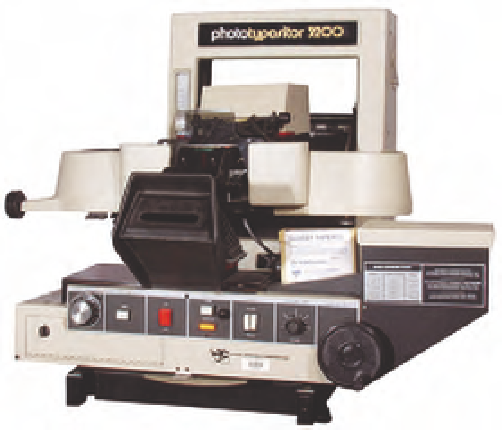Graphics Reference
In-Depth Information
PHOTOTYPESETTING
1950s to 1970s
7-10
A display
phototypesetter.
Phototypesetting is a cold-type process, for type is set not from
molten cast metal, but by exposing film negatives of characters onto
photographic paper. Although photographic typesetting was explored
as early as the 1880s, its potential was not fully recognized until after
World War II. As printing advanced from letterpress to offset lithography,
typography underwent a similar evolution. Hand composition of
metal display type, and cast metal machine-set text type, yielded to
photographic typesetting. Two kinds of phototypesetting systems were
developed: display phototypesetters, for larger headlines and titles; and
keyboard phototypesetters, used to set text type through keyboard input.
Phototypesetting gradually replaced metal type during the 1960s, as the
technology improved rapidly.
Display phototypesetting
In display phototypesetting machines (Fig.
7-10
), light is projected
through film negatives and a lens to expose letters, numbers, and
other symbols onto a strip of photographic paper. While a font of type
in hand composition consists of a drawer full of raised metal letters,
a font for display photo composition consists of clear images on a
long strip of film (Fig.
7-11
) wound on two reels. This film font slides
between an amber safe light and a lens. Characters are projected onto
a strip of photo paper resting in a shallow tray filled with a developing
solution. An operator uses hand cranks to roll the strip from one
drum to another, putting the next letter in position to be exposed.
By pressing a button, the operator causes a bright white light to flash
thorough the lens, exposing the character to the photo paper (Fig.
7-12
).
The character immediately begins to develop, so the operator sees it
while using a lever to advance the photo paper. The projected image
for the next character is positioned by winding the film strip on the
reels with hand cranks. Character by character, a line of display type
is exposed on the photo paper, then developed and fixed. Because the
operator can view recently set characters as they develop, letterspacing
is precisely controlled (Fig.
7-13
). This spacing flexibility was a major
innovation. Many design advantages of display phototypesetting made
it the dominant method for setting headlines by the late 1960s. No
longer constrained by the fixed sizes of metal type, the designer could
now specify display type set from the film font (whose capitals were
about an inch tall) in a wide range of sizes. Type could be enlarged up
to two times the master font size, for two-inch capitals, or reduced to a
one-fourth size, with capitals as small as a quarter inch high. Enlarged
and reduced type retained perfect sharpness, unlike metal type, which
became very ragged when enlarged. Metal fonts had a limited number
of characters, while photo type had an unlimited number of characters,
because the same negative could be exposed over and over again.
7-11
Film font for a
display phototypesetter.




